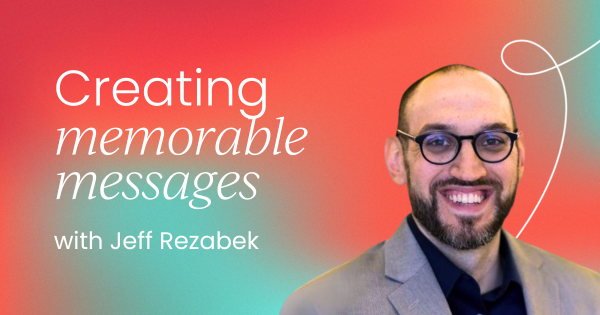In product marketing, it's assumed that you'll be tasked with creating slides, doing competitive intelligence, and conducting a messaging exercise in every role. Despite many books and articles on messaging, many product marketing professionals still feel overwhelmed by the thought of running a messaging exercise.
The reality is… they are overwhelming.
Running a messaging exercise requires a lot of work and a lot of input - and they don't always work out. But, every time you embark on a messaging exercise, you add another tool to your tool belt for the next one.
You build your craft. You get better. You know what to look out for. You know who to include.
This post provides some tips and lessons I've learned through my messaging experiences to help give you a jump-start.
- Understanding your audience
- Understanding your product
- Defining your core messaging
- Tailoring messaging to different channels
- Testing, learning, and iterating
1. Understand your audience
Early in my product marketing career, I thought you could jump into a messaging exercise. I was very wrong.
I soon discovered that you can only build a messaging framework if you know who you're trying to talk to. This is why understanding your ideal customer profile is vital. Before you put pen to paper, review your personas. If your organization still needs documented personas or they need to be updated, you'll want to start building or refreshing those with the latest information.
When creating your personas, start the internal research. Look through your CRM, review case studies and product review sites, and interview sales and customer success teams to get their take. Listen in on sales calls and interview customers (use this as a case study opportunity).
As you collect the information, constantly ask:
- Who needs our offering the most?
- What problem are they trying to solve?
- Why is it a problem?
- What are they currently doing?
- What happens if they can't solve the problem?
- How does our offering help?
- What value are they getting?
2. Understand the product
Now that you understand the audience, you'll want to clarify how your offering can help solve the problems and provide value to your different personas. This is where you start using your software. Read over the documentation and schedule regular sessions with the product team.
Start documenting the features that matter most to your persona. Ask what the feature does, how it works, what problem the feature solves, and how your customers get value out of it. Most importantly, ask how it's different from what your competitors - or worse, doing nothing - do.
When you've compiled a list of all the main features documented, take a step back and organize them by different value themes. Things may not perfectly align; sometimes, a feature can fit into a few different buckets. When there is a crossover, think about the feature from your personas' frame of reference and what they would like more about it.
3. Define your core messaging
You should start to see your messaging framework shaping up. With your features neatly organized, you should be able to identify the value pillars that your personas care about the most.
Now is the time to start writing. Start with your long message. Don't limit yourself to a word count here. Write as much as you need to. This will be the ugly first draft.
After you have that ugly draft, cut the jargon, forget the filler phrases, and undo the unnecessary superlatives. You still don't have to worry about word count here. The goal with the long version of your messaging is to clearly communicate the problem you solve, who benefits the most from your offering, how you will make their life better, and how you are different from not only your biggest competitor but also the status quo or the DIY solution.
4. Tailor messages to different channels
This next step is probably the most challenging part of messaging. Take what you've developed in your long-form messaging and look for ways to simplify and reduce it while retaining the original feel. You'll go through multiple revisions of this. You'll think you have it nailed down, but a week later, you may return and want to start all over. But the effort is worth it when you get it.
Think of all the different places where your messaging will appear and how the messaging will need to be recalibrated to fit different character limits.
I break it down to the following word count to give you a few options. Doing this now will save you time in the long run:
- 100 words - Useful for press releases, solution briefs, analyst reports, and usually anything with longer-form content.
- 50 words - Multipurpose.
- 25 words - Useful for social posts.
- 10 words - Used mostly as headings on web pages or slides.
5. Test, learn, and iterate
Messaging is never done. It will constantly evolve as your offering matures and your market shifts. However, if you get it right, your message will stabilize a bit.
When you're interviewing a customer for a case study and hear them paraphrase your messaging, that's when you know you've nailed it - for now. Don't assume that your messaging is done and over with.
You need to keep a pulse on the market, buyers, customers, and competitors to see what's resonating and what is starting to fizzle. Test the messaging. Look for shifts in the market, new values, and new problems that your offering solves. As your offering matures, you may need to start at the very beginning and rethink your persona for a new market.
Some ways to test your messaging include listening to sales calls to validate your findings. Another way is to continue conducting case study interviews. As the customer details why they chose your solution and the value they get from it, listen for alignment with your value pillars. If there are any shifts or new values, dig in. Ask questions. Listen.
Finally, on the marketing side, you can test your messaging by partnering with demand gen or growth to run ads or conduct an ABM campaign. Check-in regularly to see what's working and what needs to be adapted. This is one of the quickest ways to test your messaging, connect with your audience, and make it stand out.
While messaging exercises may seem intimidating and tedious, the best way to get better at them is to roll up your sleeves and actually do them. Over time, you'll find a process, strategies, and tools that work best for you. As long as you're willing to try, adapt, and keep going, you'll be a messaging master in no time.


















 Follow us on LinkedIn
Follow us on LinkedIn



.svg?v=85af970283)